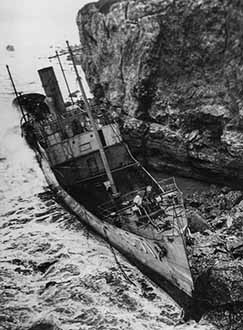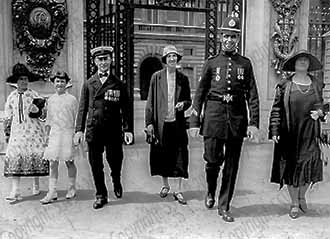Thrilling Cliff Rescue
Men on “Mystery Ship”
Hauled up in the Breeches Buoy
(From Our Own Correspondent.)
South Shields, Wednesday Night T
The rescue of two men, the only persons on board a steamer drifting helplessly in the North Sea off the Tyne, was effected at South Shields this morning under thrilling circumstances, in the teeth of a fierce gale and blizzard. Shortly after seven a.m. distress signals were seen from a vessel, and there was a quick response by the coastguards and the Shields Volunteer Life Brigade.
The vessel proved to the P.C.71, a war-time "mystery" ship, formerly toe property of the Admiralty, and which had been preceding northward from Portsmouth to a shipbreaking yard in the Firth of Forth in tow of a Middlesbrough tug. The tow-line had broken in the wild weather, and vessel, after being buffeted about for five hours, narrowly missed striking the South Shields pier, and finally crashed on the Trow Rocks below a high cliff.
The rocket apparatus was rushed along the coast to the point where the ship had struck, but owing to her position and the blizzard, it was some time before she could be definitely located. The cliff was descended some distance by the brigadesmen, and the first rocket shot landed on the steamer lying in broken water a hundred feet below.
Police-constable Darling, of the borough police, was among the rescuers, and pluckily descended the remaining distance means of a rope to the surf-beaten bottom. Half-blinded by hail, and among seas that were smashing against the cliffs, he succeeded in securing the line that had been fired over the vessel, and with the assistance of Coastguard White, and others who were lowered over, he got ashore the two men on the vessel, Peter Campbell and John Whitehead, both of Limekilns, Fifeshire.
Precarious Position
This operation, however, did not complete the rescue. Situated as the little party was at the foot of the cliff, seas swirling about them, their position was still somewhat precarious. The breeches buoys were soon requisitioned, and one by one both rescued and rescuers were hauled up the towering cliff side to safety. It was a gallant rescue, and almost all who took part in it were bordering on exhaustion. The rescued men were hurried to the Brigade House, and there comforted.
A vivid account of the terrifying experience Campbell and Whitehead had undergone was given by the former when he had somewhat recovered. The P.C.71, he said, was being taken to the Charlestown shipbreaking yard to be broken up. She was built in 1918, and was in service during the war as a “mystery" ship, being fitted with turbines and capable of steaming at 23 knots. “We left Portsmouth on Saturday and encountered terrific weather off Spithead, and for four days the gale continued with unabated fury." he said. “We were the only men on board and the vessel was absolutely dependent on the tug. So violent was the motion of the ship that for four days we had been lying practically helpless in the chart house, unable to stand on our feet. It was late last night we realised the tow-line had parted, and that we were adrift. We put our lifebelts, and, after lighting flares, just waited in the chart house for what we thought would be the end."
The P.C.71 lies close up to the rocks, and it is probable that she will become a total wreck.
Source: Yorkshire Post and Leeds Intelligence 26 November 1925
NOVEMBER 25. – The alarm guns were fired at 7.15 a.m., a vessel having been observed in distress off the coast. There was a strong north-east gale blowing with heavy snow showers. The Brigade mustered and the rocket wagon was taken towards the Trow Rocks, where the vessel was observed to be drifting. She finally grounded under the high cliffs at the south side of Ladies’ Bay, or more properly called Graham’s Sand, as it is described in Admiralty charts. After various adventures the Rocket Wagon was got to a spot about 40 yards from the stranded steamer, and the first rocket was successful in establishing communication. In the meantime members of the Brigade and several helpers scaled the high cliffs immediately over the vessel, and P.C. Darling, of the South Shields Police, was lowered over the cliff, the vessel then being about 15 yards away. A line was thrown from the ship, and to this P. C. Darling attached another line, and by this means the only two men on board were rescued. All this was a particularly hazardous proceeding. Darling by this time was accompanied by Station Officer White, who also descended the cliff to help him. The breeches buoy was lowered down the cliff, and the two men, with Darling and White, were hauled up by the Brigade, many of whom were in a very exposed position on the top of the cliff. All were taken to the Brigade House and given dry clothes and refreshments. The Officers and members of the Brigade present exhibited much courage and deserve great credit for work performed under trying circumstances. The ship afterwards was proved to be P. C. 71, one of the war-time “Mystery-ships” which was on its way from Southampton to the Firth of Forth. The watch was continued all day till about 5 o’clock in the evening, when, as the weather had been moderating for some time, the Brigadesmen were at liberty to return to their homes.
Source: Annual Report 1925
Cliff Rescues
King's Medal for Two Daring Men.
An interesting story is revealed in a Board of Trade announcement last night of the King's award of the silver medal for gallantry in saving life at sea to Police Constable James Darling, of South Shields, and the bronze medal to Station Officer Wm. Henry White, of the Coastguard there.
Lowered down the cliff when the ex- Admiralty vessel P.C. 71, in tow for breaking up, stranded Trow Rocks during a heavy gale last November, with two men aboard, Darling, after failing to reach them with a line he carried, established connection with the aid of another line thrown from the ship, and hauled the men successively to his position at the foot of the cliff.
The life-saving apparatus arrived, and one of the survivors was hauled up in the breeches buoy. When it was lowered again the constable and the other man were exhausted, and signalled for assistance. Station Officer White, sliding down the rope into the sea, assisted first the other survivor and afterwards the constable into the breeches buoy. They were brought to safety, White using another rope to steady the breeches buoy and prevent the men from being dashed against the cliff. White was then hauled up at considerable risk to his life.
Source: Aberdeen Journal 9 April 1926


